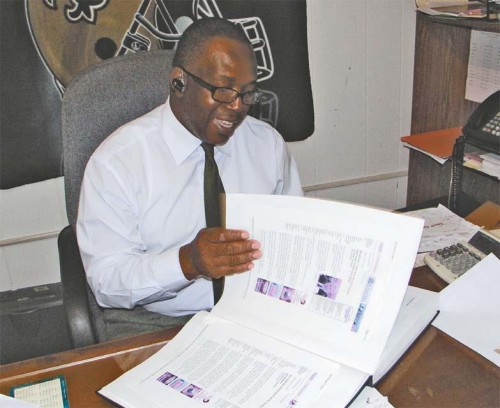
Tillman talks Terrebonne, reflects on vital three terms
September 6, 2011Thursday, Sept. 8
September 8, 2011Alligator hunting season is different from most other wildlife harvesting events in Louisiana because it accounts for a month’s worth of income among its participants.
While controlling the population of these reptiles, hunters who pay $25 for in-state licenses, $150 for non-residents, and have tags issued to them by the Louisiana Department of Wildlife and Fisheries, based on the number of acres they cover, often rely on the 30-day season. The season began last Wednesday for the eastern zone, which includes Lafourche and Terrebonne parishes, and today for the western zone, which includes St. Mary Parish.
“[In 2010] we harvested about 27,000 alligators,” Louisiana Department of Wildlife and Fisheries Alligator Program Manager Noel Kinler said. “We expect to harvest about 32,000 this year.”
“The big alligators are going to be a little better than last year,” predicted Al Mahler, owner of Big Al’s Seafood in Houma. In turn he anticipates overall income per gator will be slightly higher this year.
Mahler said that during the 2010 season, hunters received $15 per foot on alligators that were 7-foot-long and larger. This year he is paying $26 for alligators 9-foot-long and larger, $20 for those between 8 and 9-foot-long, $15 for catches between 7 and 8-foot, $8 for 6 to 7-foot, $4 for 5 to 6-foot and $2 a foot for alligators between 4 and 5-foot in length. “You can see why they don’t want to be catching the little ones,” he said.
The alligator skins make the bulk of money for buyers as many are sold to tanneries in Europe as well as the U.S.
Additionally, a taste for alligator meat has also gained renewed popularity and prices this year are at $1.25 per pound in comparison to the 85 cents per pound suppliers were making in 2010.
“The demand for alligator skins suffered greatly as a result of the economic recession in 2008 and 2009,” Kinler said. “Prices for skins dropped dramatically during that time. What we are seeing is a recovery in the alligator skin market.”
A final count for the overall 2011 licenses and tag distribution was not complete by press time. Based on available numbers, Kinler confirmed that this year is offering greater hunter participation than during 2010.
“Thus far in the eastern region we have issued 2,438 alligator hunting licenses and 34,000 tags,” Kinler said. “That is going to change a bit [once the western region is completely tabulated.”
In 2010, the entire season for the state saw a total 2,247 licenses purchased and 32,000 tags issued, offering a notable increase in hunting activity for 2011.
Although he acknowledged public popularity with the History Channel program “Swamp People” Kinler said he does not think that is the reason for increased hunting participation this season.
In Cut Off, Gerald Savoie both hunts wild alligators and farms the reptiles. “I couldn’t tell you a percentage, but it does look like [the harvest] will be better than last year,” he said.
With a 30-day season, a hunter with 100 tags filled on gators valued at an average of $150, could see a take total of $15,000.
Savoie confirmed that although prices per animal appear good, it is important to keep in mind the expenses hunters incur for bait, equipment, boats, fuel for those boats, guns, ammunition, leases many pay for the use of swamp and bayou property, as much as 50 percent of their take can go to the landowner, and the time invested during the month-long season.
“They may only clear half of their total [earnings] at the buyer by the end of the season,” Mahler said.
Claude Luke Jr., of Houma, checked in 16 alligators at Big Al’s on his first day of the season. He was issued 75 tags by the LDWF based on the acreage he is covering.
Luke confirmed that the sooner he fills his tags and shortens his season, the better it will be for him economically, and feels confident that his goal could be met. “[Alligators] seem to be active,” he said. “You see them all over the place.”
Mahler said that although improvement to the alligator market is anticipated this season, there are still influences from overseas areas where caymans and crocodiles add to the competition.
According to LDWF calculations, Louisiana’s wild alligator population is approaching 2 million and more than 300,000 are being raised on farms. Raw meat and hide values for the season are projected to approach $57 million. Those values do not reflect increased hide values after tanning and product manufacturing, or values associated with jobs or tourism.
Alligators have been commercially hunted in Louisiana since the 19th century. Harvest was unregulated until the 1950s when population declines became an issue. Between 1962 and 1972 alligators were considered endangered, and as a result were federally protected as the population was allowed time to grow. Hunting resumed with controls in 1973.
Louisiana leads the alligator industry. Between 2008 and 2010, the in-state market saw a drop in value of more than $5 million. Industry insiders hope they will see a notable rebound this year.
“A lot of [hunters] are not going to fish until prices get better,” Mahler said. “Maybe this year the price will be better and they will go out. It depends on how much money they need.”








